
13 Effective Strategies to Increase Your Blog Traffic
You’ve launched your new blog but you’re still struggling to increase blog traffic. Or you simply cannot manage to drive more traffic to your existing blog.
No need to worry, though, since you don’t need to be a marketing guru or read countless “ultimate” guides!
We’ll present you with 13 simple and proven methods to increase your blog traffic and improve the readership of your blog!
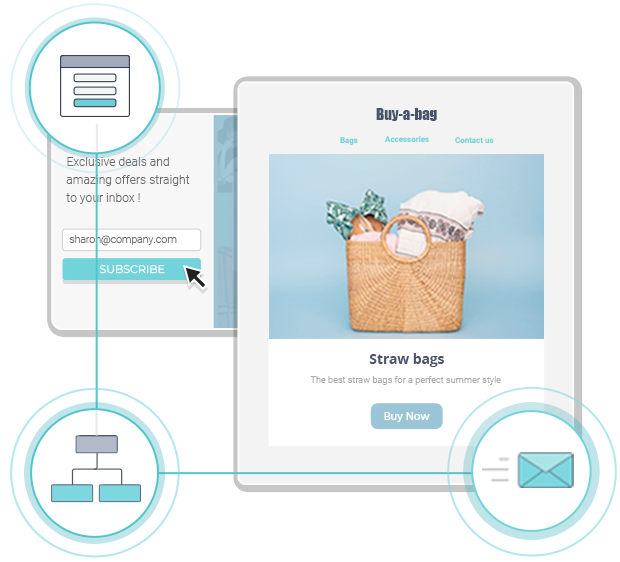
The easiest and most affordable email marketing and newsletter software!
1. Conduct keyword research
You may be tempted to write about topics that get you excited. The reality is that while with those topics you may see a spike in traffic upon publishing, it will soon diminish.
So, what you need to do to have consistent organic traffic on your blog is to conduct keyword research and identify topics that people are actually interested in. You may think you know what people are searching for, but the only educated call is to use a keyword research tool such as SEMRush or Ahrefs.
The process is relatively simple. Just type in the keywords you’re interested in and see the stats that come up. The main stats to look for are volume and keyword difficulty.
For example, let’s take the keyword “landing page builder.”

The volume illustrates the number of searches this keyword is getting, while keyword difficulty shows how easy it would be for you to rank for that keyword.
You need keywords with significant volume but not super high demand.
Set some boundaries and goals in terms of what you are looking for in these stats and be consistent for at least several months.
Don’t shoot for the stars, aim for the low-hanging fruit and you will get your chance for trophy keywords later in the game if you are consistent.
We think that keywords with volume over 50 and difficulty of less than 40 are good targets to start with. If you can’t find keywords that meet these goals reiterate your content ideas until they make sense.
However, proper keyword research requires you to match search intent and study your competitors. These will be examined in the following sections.
2. Match search intent
To rank high in Google and get and get precious search traffic, you need to create content that is aligned with the users’ search intent. This means you need to identify:
- what type of content to create: content types include a blog post, product, category, landing page, or video.
- the type of format your post will have: providing you’re going to create blog posts, they can fall into the categories of listicles, how-tos, reviews, opinion pieces, etc.
- the unique angle of your content: this is the “selling point” of your article. If you succeed to write a blog post about the target keyword you want while providing something new to users, then you are one step away from success. Here is an example with the long-tail keyword “how to create a landing page”

Apparently, people want to learn how they can create a new landing page for their business fast. This means that your piece of content must cater to the needs of beginners.
3. Start building links
Backlinks are still an important Google ranking factor. In fact, according to a study conducted by Ahrefs, backlinks have a close relationship with organic traffic.

In case you didn’t know, a backlink is a link leading back to your content from an external website. And while generating backlinks for your blog posts is crucial, many bloggers seem to struggle, regardless of their experience.
Among the many link building strategies, there is one that we think you shouldn’t ignore. This is guest blogging. Guest blogging is when you write a guest post for another website/blog.
To identify potential opportunities with other blogs, you can use tools like Ahrefs and specifically their Content Explorer tool. Once you’ve found them, you need an outreach tool like Pitchbox to contact these blogs and pitch them your idea/business proposal.
Note: This strategy can yield tremendous results if you are consistent and go for the “long” game.
Other equally useful strategies to generate backlinks include:
- Reach out to influencers or blogs in the industry you are in, and ask them whether they want to link to specific content on your blog.
- Establish “partnerships” with other blogs and share high-quality content.
- Make interviews with bloggers and influencers. Their users will come to check out their interview and you get a backlink.
Finally, you can add a link to your website on the social media profiles you maintain.
4. Grow your email list
Beginner bloggers usually put all their efforts into bringing new users to their website. What they don’t realize is that to increase blog traffic you don’t just need new users, but also your existing ones. In fact, you have to keep them coming back.
To increase blog traffic, you need to grow your email list by creating an opt-in form on your blog. The best way is to provide something valuable in return for the users’ email addresses. This is known as a lead magnet and it can be an ebook, checklist, cheatsheet, etc.
For example, OptinMonster sends free optimization tips and resources to persuade users to sign up:
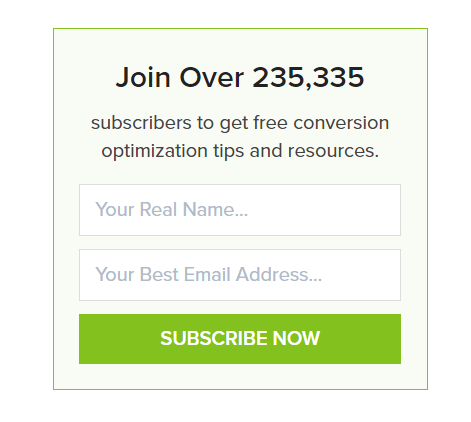
Alternatively, you can place a popup or floating box on your website that allows users to sign up. Here is an example from our own website:

But why is it important to grow your email list? Well, because email is still among the best communication channels with your audience! You can contact them at any time, directly in their inboxes.
On the plus side, you own that email list. So, there have no risk losing it or getting your reach limited (like with social media platforms). Limited reach means users can only see some of your content.
Once your email list starts getting bigger, you can leverage the power of email marketing to inform users about new blog posts, thus bringing in more traffic to your blog.
5. Design click-worthy headlines
It is of vital importance that your headlines capture the users’ attention and drive more clicks. The headline is the deciding factor leading users to either read through your blog post versus simply skipping it.
But how can one create catchy headlines that get clicked?
If your blog post content matches search intent, then your headline can be crafted as follows.
Let’s say you’ve created a post about the best email marketing services. The headline can include the number of services, the specific year it is about and the unique elements of your post (e.g. comparison table, in-depth analysis, etc.)
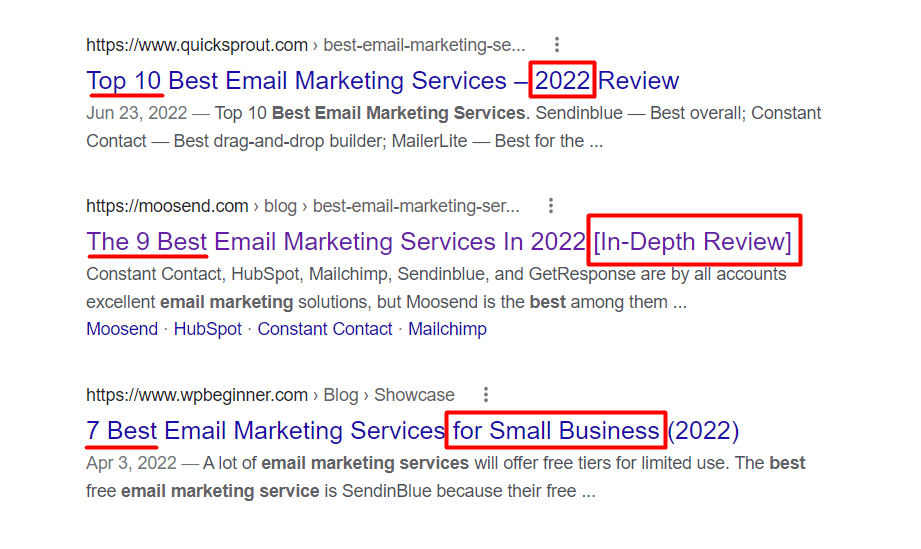
Sometimes (as in the above example) this may be not enough as the SERP results look similar to each other. So you can’t be sure the click will be yours.
Here are some other tactics you can leverage to craft effective headlines:
- Create curiosity gaps: Make users want to click in order to learn the answer or reveal the “secret” of the headline. For example, you could say “How we increased our blog traffic by 304% in 9 months.”
- Provide extra value or reward: You can create content upgrades (i.e. downloadable content) to accompany your blog posts and let users know from the headline. For example, your headline could be “25 GDPR Stats You Need to Know About [Infographic included]”
- Be very specific: Instead of saying “How to Create an Online Form” your headline can be “How to Create an Online Form in 6 Easy Steps”
- Trigger an emotional response: This is mostly for posts designed to spread fast or go viral on social media. You can aim to induce shock, curiosity, excitement, greed, etc. For example, including the word “free” can induce greed and, in turn, increase your open rates.
6. Contact people mentioned in your blog posts
If you’ve created an in-depth piece of content, it is highly likely that you’ve mentioned resources from other bloggers or websites. So, reach out to them and let them know.
This tactic may seem simplistic, but the people mentioned can share your blog post on their social media profiles and drive some extra traffic your way. And it only takes a few minutes to compose the email that you’re going to send. You can even create a template and save time.
Apart from increasing your blog traffic, this strategy is helpful in terms of building a relationship with other bloggers. This could then develop into a business partnership, link exchanges, mentions, etc.
7. Conduct internal linking
While great content can help your articles rank in search engines, it is not enough by itself. You should infuse your blog posts with links from previous blog posts you’ve published. This strategy is called internal linking and it plays a major role in search engine optimization (SEO).
First and foremost, it helps Google understand the relationship between different articles on your website. Moreover, if these internal links are placed contextually, they can help boost performance and increase pageviews.
If your blog is relatively new and you haven’t got loads of articles already published, you could conduct internal linking manually.
Alternatively, you could use tools like Yoast SEO (its internal linking feature) or AIOSEO. These tools provide helpful suggestions for internal linking and you can be done with internal linking within mere minutes.
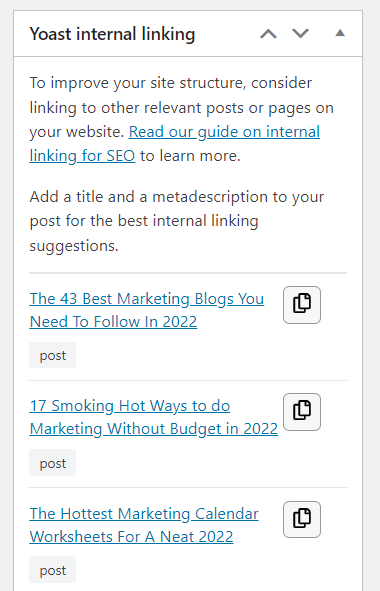
So, it’s a good idea to make internal linking an integral part of your pre-publish checklist.
In case you want to know more about internal linking, check out this guide on internal linking strategies for SEO.
8. Use visuals to create visually attractive content
Most people dislike reading long walls of text. Not to mention that people’s attention span is limited. To mitigate this and make your blog content easily readable and visually appealing, you need to use visuals (images, infographics, charts, etc.)
Using images in your blog posts, you can grab people’s attention and help them focus on the text around those images.
Ideally, you should use your own images but not everyone is a skilled graphic designer. In the beginning, you can use royalty-free images or take screenshots you like. In the latter case, be sure to provide the source or you may face consequences of copyright infringement.
Visuals can also be used when you want to provide information in a more eye-pleasing way. For example, instead of using simple bullet points, you can have a nice visual. This will make your content look better and you can always repurpose those visuals or use them as bite-sized pieces of content on social media.
Here is an example:

We created a nice visual about the defining characteristics of a good landing page. Our goal was to drive attention to the image and ensure users wouldn’t skip this part.
If you plan to go the DIY way, you can try out tools like Canva that make image creation a breeze even if you’re a complete amateur.
9. Share content on online communities
Online communities are great places to promote your content and drive traffic to your blog. In the past, blog promotion relied heavily on forums and message boards.
Now online communities are in the form of Facebook groups, LinkedIn groups, Slack channels, Reddit groups, or even Discord servers.
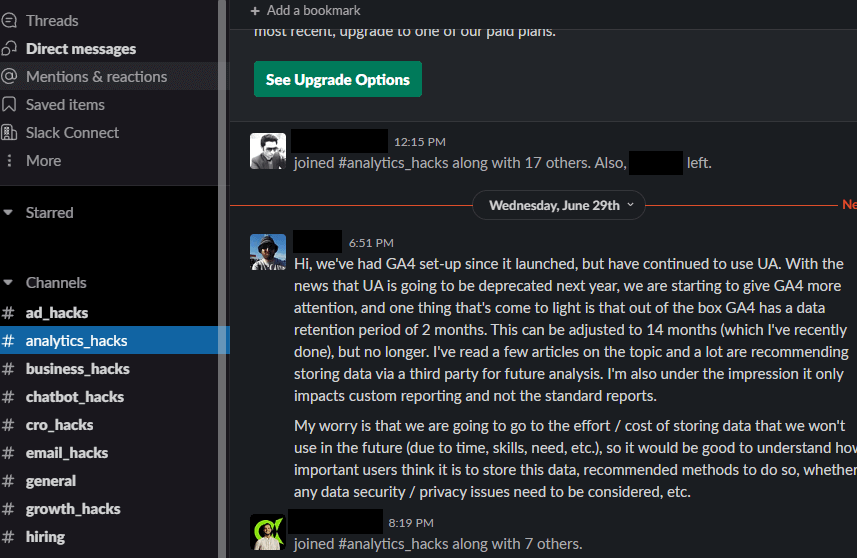
Such groups are ideal to promote your blog content since users there are highly engaged and interested in your niche.
However, you shouldn’t just join some online communities and start spamming them with links to your articles. This will get you banned or blocked in no time!
It’s all about preparation. Spend some time “studying” the culture of the group, answer questions and contribute to the group to gradually build your reputation. You’ll soon know more about what posts aren’t allowed and what kinds of posts yield more engagement.
If you’re very active, chances are you’ll be noticed by the moderators. You can build a relationship with them and ask how you can be helpful to the group.
This strategy should work well with most groups. From then on, you should be able to share your blog’s content without fearing any negative consequences.
10. Optimize page loading times
Nobody wants to wait for a website to load. Users will simply leave if they find out your website is slow. But that’s only just one part of the equation.
Google considers website speed and page load time as an important ranking factor.
The first thing you can do to ensure your website loads fast is to optimize your images. You can do it with free online tools or WordPress plugins like Smush.
Additionally, you need to use caching. Website caching is technology helpful in improving rankings in search engines and increasing conversions. Among the most popular tools for the job is W3 Total Cache, which is free, while a powerful premium alternative is WP Rocket.
11. Rewrite and republish old content
Often you’ll notice that some of your articles aren’t performing as you’d want them to or they need to be infused with more recent content. Alternatively, the case could be that they are not matching search intent.
No matter the case, the good thing about blogging is that you can refresh your content and republish it to perform better and start bringing in more website traffic.
The process of updating old blog posts is something that we also do here at Moosend as part of our content marketing strategy.
With the help of Yoast Duplicate Post and specifically its “Rewrite and Republish” feature, we do the necessary updates to blog post content without taking it offline. A duplicate version of the post is created and once you’re done refreshing the content, it is merged into the original post.

The best thing of all is that it is completely free and easy to use.
12. Share content on social media
Social media is another channel you can use to reach your blog traffic goals.
You don’t necessarily need to create entirely new content for your social profiles. It is a good idea to repurpose blog content and adjust it to fit the standards of each platform you use.
You have to be consistent and post regularly otherwise your Facebook posts or tweets will disappear soon from users’ feeds.
It’s easy to automate sharing on social networks with platforms like Buffer.
13. Run ads
Another straightforward way to increase blog traffic is by running ads. You simply select a platform and traffic will follow almost immediately. As you can understand though, this tactic may not be sustainable in the long run, so you should also invest in SEO to appear high in search results.
The most popular way to run ads is Facebook Ads, but you can also leverage Twitter and Quora. Display advertising is also a good idea.
One way to approach this safely is to run ads for some of the most important pieces of content you publish and see how it goes.
One thing to keep in mind is to do your research and select the platforms that your target audience uses in order to get the best results.
Bottom Line
Try to get your content to rank for the target keywords to get organic search traffic. Gradually grow your email list and leverage email marketing and paid advertising to keep them coming back.
As you saw, there are a plethora of ways to increase your blog traffic.
But if you want to do it quickly, it would be wise to combine the aforementioned strategies.
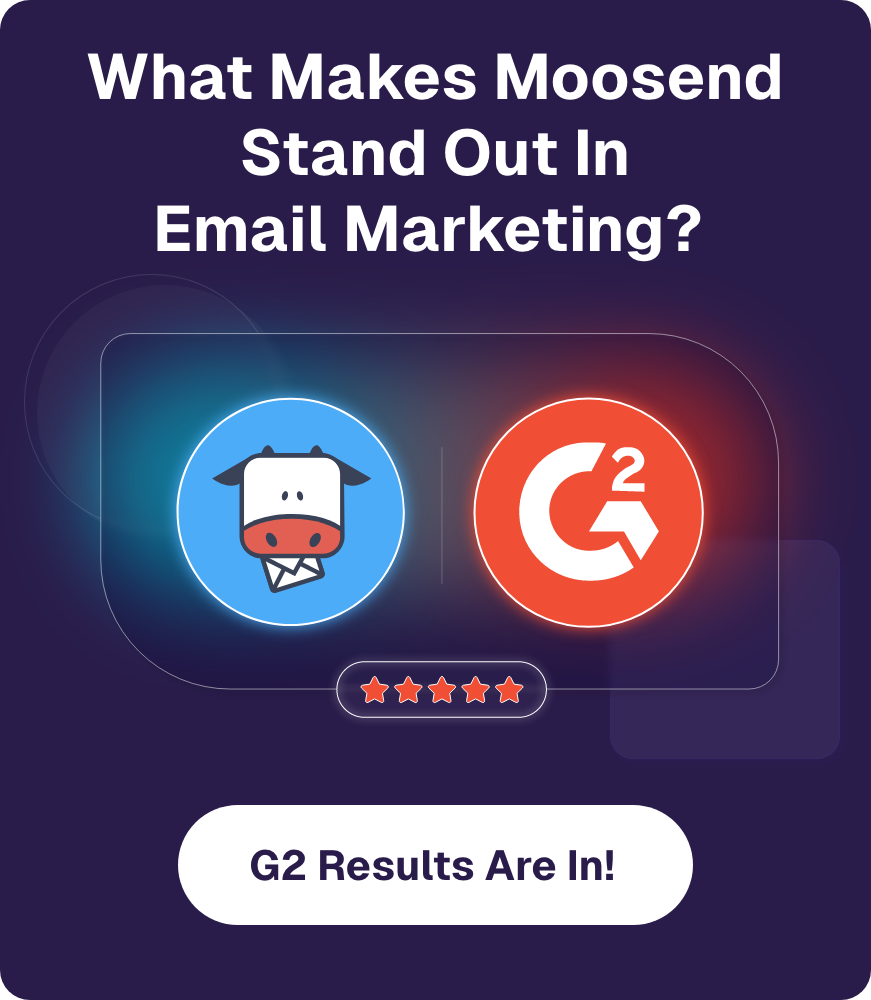



 Published by
Published by
